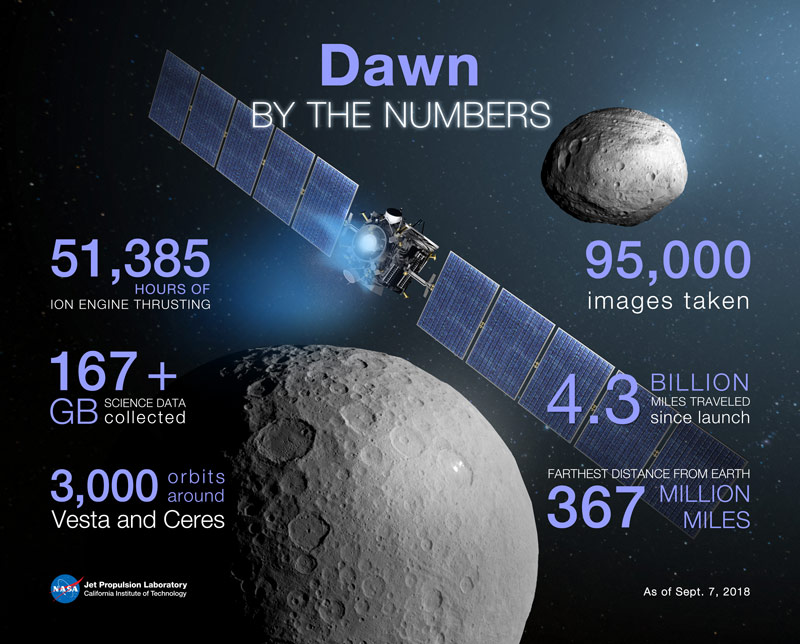Dawn Firsts
- Dawn was the first mission to visit Ceres and the first mission to visit Vesta. Ceres and Vesta are the two largest objects in the main asteroid belt between Mars and Jupiter
- When Dawn arrived at Vesta, it became the first spacecraft to orbit an object in the main asteroid belt
- Dawn was the first spacecraft to orbit two extraterrestrial targets
- When Dawn arrived at Ceres, it was the first spacecraft to visit a dwarf planet

NASA/JPL-Caltech
Spacecraft
- Dimensions: 5.4 feet (1.64 meters) long, 4.2 feet (1.27 meters) wide and 5.8 feet (1.77 meters) high. High-gain antenna is 5 feet (1.52 meters) in diameter. Solar array is 65 feet (20 meters) long, tip to tip
- Spacecraft weight: 1,647.1 pounds (747.1 kilograms)
- Propellant at launch: 937 pounds (425 kilograms) xenon propellant for the ion propulsion system
- Estimated propellant remaining*: 31 pounds (14 kg)
- Pointing control at launch: four reaction wheels, augmented by 100.5 pounds (45.6 kilograms) of hydrazine
- Pointing control at end of mission*: hydrazine only, fuel ran out on Oct. 31, 2018.
- Power: Two 27-foot-by-8-foot (8.3-meter-by-2.3-meter) solar arrays, together providing more than 10 kilowatts at Earth’s distance from the Sun and 1.4 kilowatts at Dawn’s (and Ceres’) maximum distance from the Sun. Each wing-like array weighs almost 139 pounds (63 kilograms). Energy storage via 35-amp-hour rechargeable nickel hydrogen battery
Ion Propulsion System
- Number of thrusters: 3
- Thruster dimensions (each): 13 inches (33 centimeters) long, 16 inches (41 centimeters) in diameter
- Weight: 20 pounds (8.9 kilograms) each
- Spacecraft acceleration via ion propulsion at full thrust: 0 – 60 mph in 4 days
- Thrust: 0.07 to 0.33 ounce (19 to 91 millinewtons)
Mission
- Launch: Sept. 27, 2007, 7:34 a.m. EDT (4:34 a.m. PDT) from Cape Canaveral Air Force Station, Florida, Pad 17B
- Launch vehicle: Delta II Heavy 2925H-9.5 rocket including Star 48 upper stage, provided by United Launch Alliance, Denver
- Mars gravity assist: Feb. 17, 2009
- Vesta arrival: July 16, 2011 EDT (July 15 PDT)
- Vesta departure: Sept. 5, 2012 EDT (Sept. 4 PDT)
- Ceres arrival: March 6, 2015
- Prime mission conclusion: June 2016
- First extended mission: July 2016 - October 2017
- Second extended mission: October 2017 - November 2018
- End of Mission: Nov. 1, 2018
Program
- Cost: $500 million total, including $370 million to build and launch the spacecraft and $130 million for 11 years of operations and data analysis
More Resources
Press Contacts
Gretchen McCartney
Media Relations Specialist
Jet Propulsion Laboratory
4800 Oak Grove Dr.
Pasadena, CA 91109
818-393-6215
Keep Exploring





